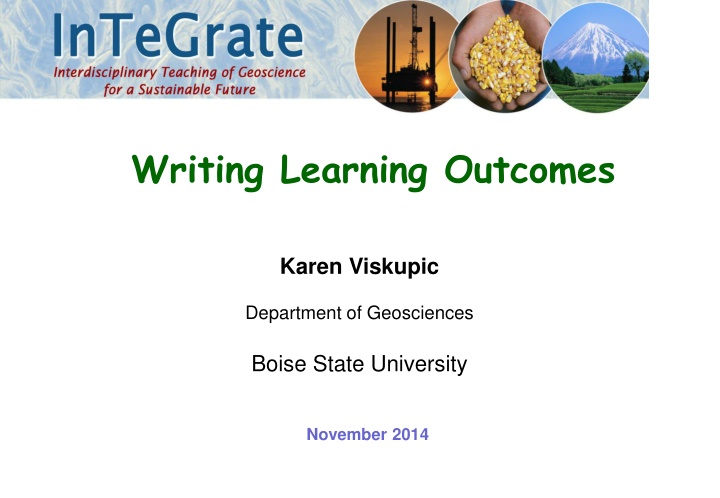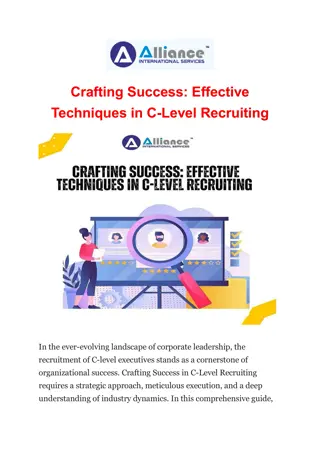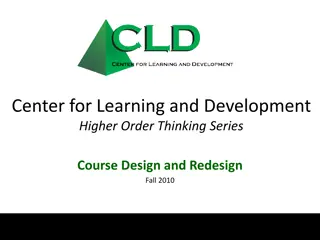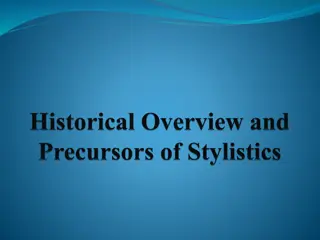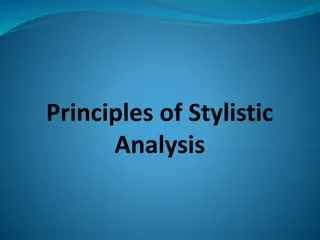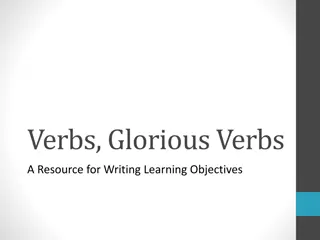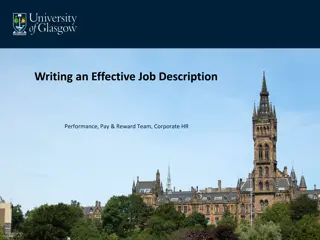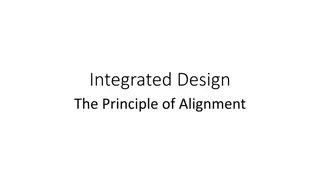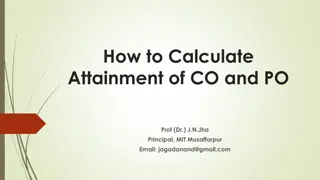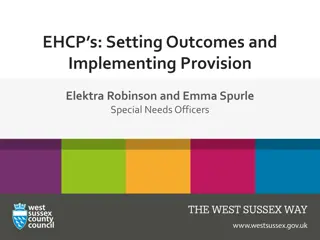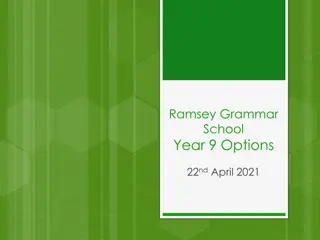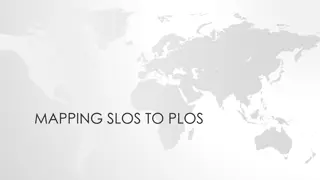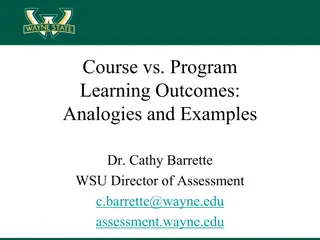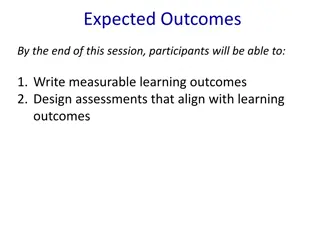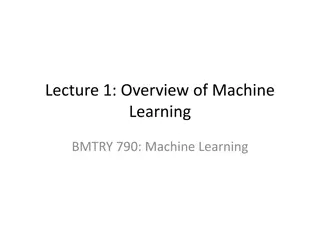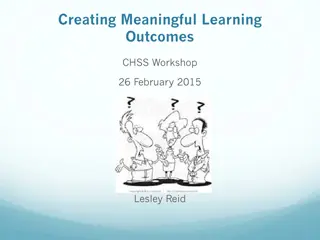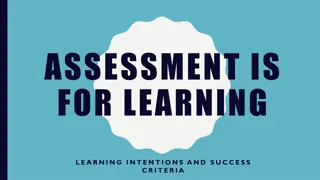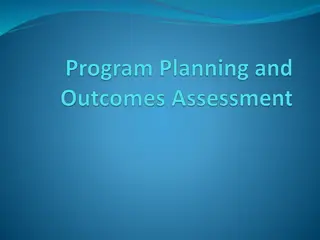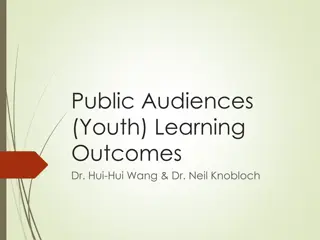Crafting Effective Course Learning Outcomes
Develop clear and measurable learning outcomes using backwards design principles. Understand the characteristics of good learning outcomes and utilize Bloom's Taxonomy to choose appropriate action verbs for goal setting. Enhance teaching strategies and assessment methods to align with defined outcomes.
Download Presentation

Please find below an Image/Link to download the presentation.
The content on the website is provided AS IS for your information and personal use only. It may not be sold, licensed, or shared on other websites without obtaining consent from the author.If you encounter any issues during the download, it is possible that the publisher has removed the file from their server.
You are allowed to download the files provided on this website for personal or commercial use, subject to the condition that they are used lawfully. All files are the property of their respective owners.
The content on the website is provided AS IS for your information and personal use only. It may not be sold, licensed, or shared on other websites without obtaining consent from the author.
E N D
Presentation Transcript
Writing Learning Outcomes Karen Viskupic Department of Geosciences Boise State University November 2014
Identify Course & Module Learning Goals Focus for this morning Pilot materials and make changes Plan Identify learning outcomes for individual lessons Instructional Strategies to implement teaching resources Design teaching resources and materials to match assessments Determine how to assess and measure student success on outcomes
Backwards Design When designing a course, module, lesson, or activity, start by thinking about what you want students to be able to do Statements of what students should be able to do as a result of your course (or module, or lesson, or activity) = Learning Outcomes (Goals)
Good Learning Outcomes (Goals) Clarify what you want students to accomplish Effectively communicate expectations to students Help you select methods, materials and assignments that are appropriate Help guide development of assessments that show what students have learned Let other faculty know what your module or course is about
What Should Learning Outcomes Look Like? Take 2 minutes to brainstorm with a partner . What are the characteristics of good learning outcomes (goals)
Characteristics of Good Learning Outcomes Specific (include an active verb) Measurable Describe meaningful learning Attainable Written in clear, understandable language
Developing Good Outcomes Use Bloom s taxonomy to select an action verb for your outcomes! Bloom s Taxonomy modified by Anderson and Krathwohl, 2001 http://www.unco.edu/cetl/sir/stating_ outcome/documents/Krathwohl.pdf
Good Module/Course Goal Verbs Analyzing - Analyze, Distinguish, Examine, Compare, Contrast, Investigate, Identify, Explain, Deduce. Evaluating - Judge, Select, Choose, Decide, Justify, Debate, Verify, Argue, Recommend, Assess, Discuss, Rate, Prioritize, Determine, Critique, Evaluate, Criticize, Weigh, Estimate, Defend. Creating - Create, Invent, Compose, Predict, Plan, Construct, Design, Propose, Devise, Formulate, Combine, Hypothesize, Synthesize, Forecast. Note: It is best to avoid LOs that include verbs such as know, be aware, appreciate, learn, understand, comprehend or become familiar with because they are difficult to observe and measure. See http://www.personal.psu.edu/bxb11/Objectives/ActionVerbsforObjectives.pdf
Lets critique some outcomes Think about the following: Is the outcome specific or vague/abstract? Is it written clearly? Would students understand it? Is it measurable? Could you design an activity/assignment/test questions that would allow you to determine whether student have met the goal or not? What Bloom s level could be assigned to this outcome (low vs. high is fine)
Lets critique some outcomes By the end of this course (or module) students should be able to . Understand why geologic catastrophes happen in some places but not in others.
Lets critique some outcomes By the end of this course (or module) students should be able to . Apply geologic knowledge to municipal planning and land use decisions
Lets critique some outcomes By the end of this course (or module) students should be able to . Describe, using metamorphic processes, the mechanisms by which heat, mass and fluid are transported in the Earth s crust, and relate them to their plate tectonic environment
Some Good Examples Explain how managing mineral resources depends on non- geological factors such as population, consumption, economics, existing and new technologies, recycling, reuse, and adoption of alternative materials. Low Cognitive Level High
Some Good Examples Low Cognitive Level Assess coastal vulnerability using an integrated social and physical approach High
Some Good Examples Low Cognitive Level Predict agricultural challenges that might result from climate change using systems thinking High
Some Good Examples Low Cognitive Level Design a standards-based interdisciplinary lesson for the secondary classroom that embeds geoscientific thinking and content as part of biology, chemistry, Earth science and physics instruction High
Developing Good Outcomes Determine several things you want students to be able to do at completion of the course/module Select an appropriate upper- level Bloom's taxonomy action verb for each Specify performance criteria Write the goal Bloom s Taxonomy modified by Anderson and Krathwohl, 2001 http://www.unco.edu/cetl/sir/stating_ outcome/documents/Krathwohl.pdf
Materials Development RubricGuiding Principles Course/module addresses one or more geoscience-related grand challenges facing society Course/module develops student ability to address interdisciplinary problems Course/module improves student understanding of the nature and methods of geoscience and developing geoscientific habits of mind Course/module makes use of authentic and credible geoscience data to learn central concepts in the context of geoscience methods of inquiry Course/module incorporates systems thinking Must score 15/15 on this section
Developing Good Outcomes Determine several things you want students to be able to do at completion of the course/module Select an appropriate upper- level Bloom's taxonomy action verb for each Specify performance criteria Write the goal Bloom s Taxonomy modified by Anderson and Krathwohl, 2001 http://www.unco.edu/cetl/sir/stating_ outcome/documents/Krathwohl.pdf
Work Time! Talk with your team and write one course or module-level learning outcome If you have time, think about what assessment you could use to measure student attainment of that outcome
Assessment of Learning Outcomes Think about the assessments you will use to measure your outcomes before you finalize them Outcomes specify learning that will occur That learning must be documented Graded assessments are the way we document that learning (can have multiple parts) You will be submitting that student work to us as part of the pilot
Module/Course Learning Outcomes What s Next? Continue working with your team to define module or course level learning outcomes Think about how you could assess that outcome Think about what activities will prepare students to meet that learning outcome Later today you ll work on unit or activity level outcomes
Climate Change Related Assessment The maps below illustrate the city of Providence, RI. Figure 1 shows the percentage of tree cover in different parts of the city. Figure 2 is a surface temperature map. (Data from Providence Urban Forest Report, 2008.) (1)Describe the general relationship illustrated by these maps. (2) Based on these data, provide a recommendation to the Providence City Council about climate change adaptation in their city.
Teacher Prep Assessment Preparing an Interdisciplinary Lesson Plan that Uses the Methods of Geoscience To cement their understanding of the methods of geoscience, pre-service teachers are given the assignment of constructing an interdisciplinary lesson plan. They will select one of the instructional resources that they evaluated in Activity 3 Part 1 and prepare an interdisciplinary lesson plan (including any student materials) that addresses at least one of the big ideas or supporting concepts from either the state's curriculum for Earth Science or from the Earth Science Literacy Principles (ESLI 2010) or the Next Generation Science Standards and at least one big idea or supporting concept from either biology, chemistry or physics. Lesson plans will be evaluated with the Rubric for Activity 3 Part 2: Lesson Plan and Student Handout
